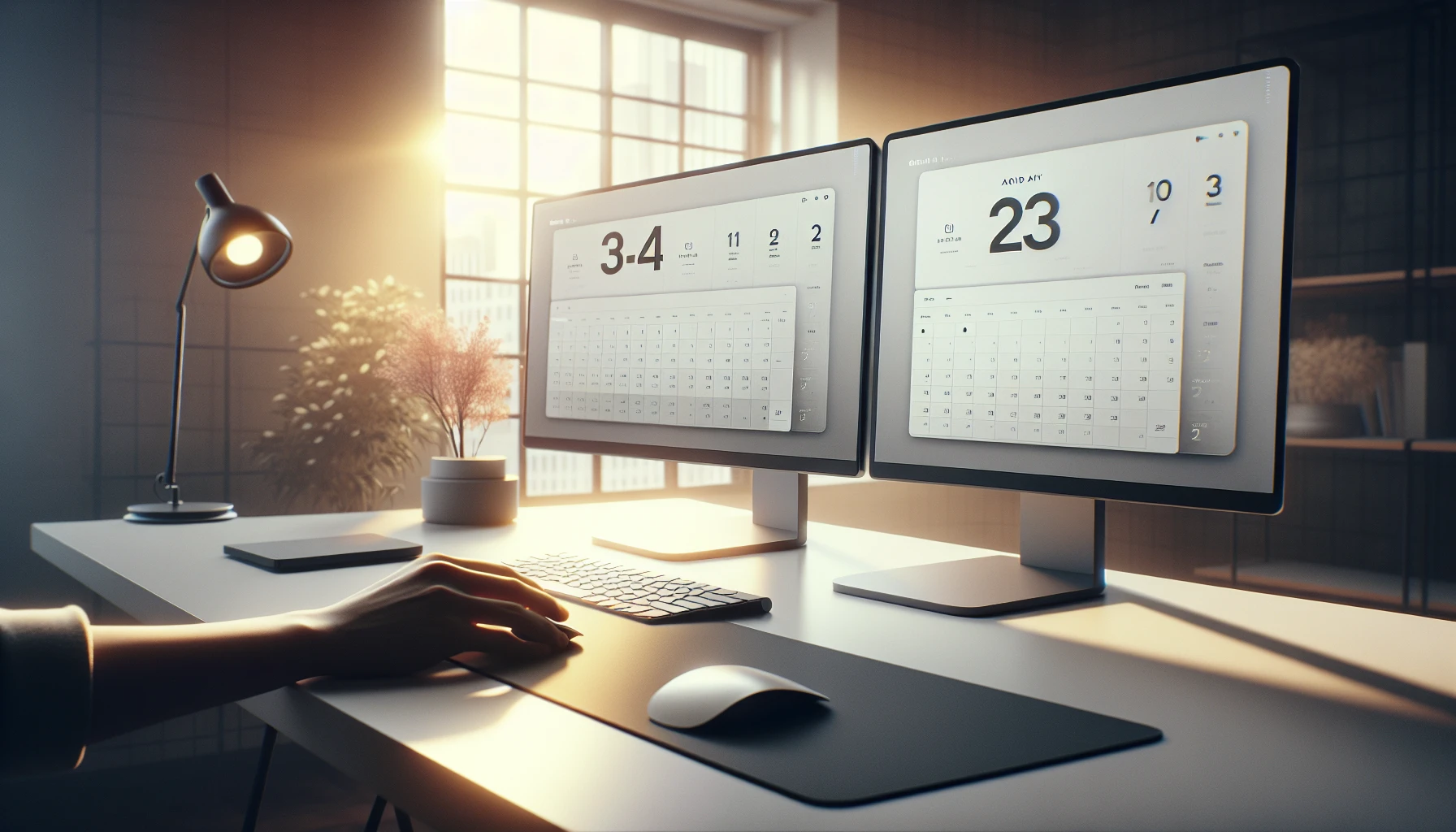· Ricardo Batista · 12 min read
How Do I Share My Google Calendar - easy steps for everyone
Sharing your calendar can be a bit tricky; these steps show simple ways to sync Google Calendar with ease using practical tools.

Sharing your Google Calendar is a handy trick to keep friends, family and coworkers in the loop—even if things can get messy sometimes. It can be as simple as giving a partial view or full details which may require a few extra steps to sort out. This guide walks you through easy ways to keep everyone synced.
Key Takeaways
- Sharing your Google Calendar is super simple and lets you manage your time better
- You have options in your settings to show only free or busy times or all event details
- Tools like Asana and Zapier help keep your events and tasks synced
- We’re experts in our field – our system even automatically pings the attendees that arrive late to your meetings, keeping things on track even when it’s a bit offbeat
- Setting the right permissions and privacy options means you stay in charge of your schedule, no messy surprises
Introduction and Overview
Google Calendar is more than just a tool for keeping track of dates and events. Many people share their calendars for easy scheduling, collaboration, or simply to keep their teams informed. When you share your calendar, you can let others see details about your meetings, appointments, or important events. One of the neat features is the ability to set up meeting reminders that, for example, automatically ping attendees who arrive late. This way, everyone stays on track and meetings start promptly.
When you share your Google Calendar, you have several options at your disposal. You can share it with specific individuals, make it public, or even limit how much detail others see. Some people might want to show all event details while others prefer only the free/busy slots. This flexibility lets you control privacy and usability at the same time. However, there are a few limitations. For instance, not all devices or applications show the same level of detail, and syncing reminders across platforms may require a few extra steps.
Step-by-Step Instructions
Accessing Google Calendar Settings
To start sharing your Google Calendar, you need to access the calendar settings. Here’s how:
- Open Google Calendar on your browser.
- Locate the calendar you want to share on the left sidebar.
- Click on the three vertical dots next to the calendar name.
- Select “Settings and sharing” from the dropdown menu.
Inside the settings, you’ll see options that let you:
- Modify privacy settings.
- Choose whether to share only when someone is free or view full event details.
- Set up permissions for each person you add.
Sharing with Specific People
If you want to share your calendar with certain people rather than making it public, follow these steps:
- In the “Share with specific people” section, click “Add people.”
- Enter the email address(es) of the person or group you want to share with.
- Choose the level of permission:
- “See only free/busy” can be enough if you want to respect your privacy.
- “Make changes to events” lets others edit, which is useful for group projects but should be used carefully.
- Click “Send” to share the calendar.
This process allows you to control who can see what. For instance, if you are working on a time-sensitive project, you might want others to see all event details so that they can get automatic reminders when meeting times are coming up or when someone is late.
Syncing with Apple Calendar Using iCal URLs
For users who work with both Google Calendar and Apple Calendar, syncing them is possible via an iCal URL. Here’s how to do it:
- In Google Calendar, go back to “Settings and sharing.”
- Scroll down to “Integrate calendar.”
- Look for the iCal address, then copy the link provided.
- Open Apple Calendar on your Mac.
- Go to “File” -> “New Calendar Subscription.”
- Paste the iCal URL and click “Subscribe.”
- Adjust the settings according to how often you want the calendar to update.
Be sure to check that the sync interval is appropriate for your needs, especially if you rely on meeting reminders and want to ensure that all attendees get the latest notifications. Note that the steps may slightly differ on a PC compared to macOS—the core idea is to utilize the URL option to bridge both environments.
Differences Between PC and macOS Approaches
While the basic process remains similar, here are a couple of differences:
- PC users typically access calendars through web browsers, and syncing with other programs like Outlook may require additional plugins.
- macOS users may find it more integrated with Apple’s ecosystem using Calendar and iCal subscriptions. This integration can result in a smoother experience when it comes to implementing functionality like meeting reminders or auto-pings for late arrivals.
Sharing the Google Calendar Link
If you’d prefer to keep things simple, you can also share a link that lets people view your calendar in a browser:
- From the “Integrate calendar” section, copy the “Public URL to this calendar.”
- Share the URL using email or chat.
- This method is best for sharing with a larger, less controlled group.
Using these steps, you can ensure that your shared calendar is a single source of truth that sends meeting reminders to all invitees. For younger users and professionals alike, the simplicity of copying a link or adding an email makes the process accessible and efficient.
Tools and Integrations
Google Calendar works well with other tools that enhance productivity. Integration with third-party applications means you can create a seamless workflow that automatically notifies people about upcoming meetings and even pings them if they’re late.
Zapier Quick Start Guide for Automated Syncing
Zapier is a powerful tool that connects different applications with simple automated tasks, also known as “Zaps.” For example, you can set up a Zap where:
- A new event in Google Calendar triggers a meeting reminder in another app.
- The reminder can be sent to attendees to alert them if they arrive late.
To start using Zapier with Google Calendar:
- Visit Zapier University 101 to learn the basics.
- Follow a quick start guide on Zapier’s website to set up your first integration.
- The process typically involves connecting your Google account, selecting the calendar event trigger, and then choosing an action (like sending a notification through an app you already use).
Integrating with Asana and Outlook
For users managing tasks alongside meetings, integrating Google Calendar with productivity platforms can further streamline workflow:
- With Asana, use the Asana Guide to set up calendar syncing. This integration ensures that any task deadline or meeting update is automatically reflected in your scheduled tasks.
- For those using Outlook, sharing techniques can range from exporting calendar data to using available plugins that synchronize events between Outlook and Google Calendar.
Using these integrations, you can ensure that your meeting reminders not only prompt your attendees about late entry but also help you maintain an up-to-date schedule across all your work platforms. This reduces the risk of missing out on crucial schedule updates and allows dynamic planning with tools that you already use.
Scheduling Links and Meeting Automation
Meeting reminders are an essential part of calendar sharing. They ensure that attendees receive pings when they are late. Many services allow you to add scheduling links to your events. Here’s how you can set them up:
- Use built-in scheduling features from Google Calendar to add a meeting link.
- For more customized reminders, some integrations with Zapier or other automation tools allow you to set up reminders that automatically send a message or email when a meeting’s start time is passed.
- Consider using tools that offer a “late reminder” feature to ping attendees who haven’t joined the meeting on time.
This approach is handy when running remote meetings or virtual sessions based on Google Calendar data. It can be particularly useful in scenarios where time-sensitive decisions are made, like project kick-offs or deadline-driven tasks.
Troubleshooting and Advanced Tips
Even when things go smoothly most of the time, you might run into issues when sharing your Google Calendar. Here are some common problems and how to fix them:
Common Pitfalls
- Permission Errors: If recipients report that they can’t see event details, double-check their permission settings in the calendar share options.
- Sync Delays: Sometimes, changes in your calendar may not appear immediately on synced platforms. A quick refresh or checking your sync settings (especially in Apple Calendar) often resolves this.
- URL Issues: Make sure the iCal URL copied from Google Calendar is complete. A truncated URL can result in sync failures across devices.
Managing Multiple Accounts
For users with multiple Google accounts, particularly on Android, glitches might occur while switching between accounts. Follow these steps to manage multiple calendars:
- Use Google’s account switching feature while in your browser or app.
- Ensure that the correct calendar is selected when making changes.
- Clear cache and refresh the app if you encounter sync issues between different accounts.
Integrations with third-party tools sometimes need special attention. It can help to periodically disconnect and reconnect your Google account to force a sync. This is particularly relevant if you need to send timely meeting reminders and auto-pings for late attendees. In case you face more stubborn issues, forums such as those on How-To Geek or Apple Support provide community-driven solutions and troubleshooting steps.
Advanced Sharing Options for Organizing Teams
If you are managing a team and need more detailed sharing capabilities, consider:
- Creating separate calendars for different types of events (e.g., one for meetings, one for deadlines).
- Allowing team leads edited access for better scheduling control.
- Using advanced filtering options so only relevant event details are shared, keeping sensitive data protected.
This level of organization not only improves scheduling but also ensures that automated meeting reminders are sent out accurately. It is especially effective for groups that need dynamic yet controlled access to calendars, helping mitigate cases where reminders might be missed if the wrong calendar version is viewed.
Leveraging Community and Online Resources
When technical issues or doubts arise, don’t hesitate to search related topics on reputable websites. Sites like How-To Geek offer extensive guides on troubleshooting, while Apple Support forums can be invaluable for macOS-specific issues. These communities provide real-world examples of similar challenges, making it easier to pinpoint solutions in your calendar-sharing adventures.
Also, checking out the official Google Calendar Help Center can offer precise, updated details on new features or changes in the interface. This is handy whether you’re tweaking your sharing settings or trying to understand how meeting reminders function across platforms.
Recap and Additional Resources
Before you finish setting up your shared calendar, here’s a quick recap:
- You learned how to access Google Calendar settings and choose sharing permissions.
- Step-by-step instructions covered sharing with specific people, syncing using iCal URLs, and differences in approach between PC and macOS.
- We explored tools like Zapier for automatic syncing and integration with productivity platforms such as Asana and Outlook.
- Troubleshooting tips included managing permissions, handling sync delays, and addressing issues with multiple accounts.
- You also saw advanced methods to ensure that meeting reminders – like automatic pings for those arriving late – are effective and timely.
For additional help and deeper insights, consider these resources:
- The Google Calendar Help Center offers official guidance and feature updates.
- Zapier University 101 is a great starting point if you’re looking to understand automation between different apps.
- The Asana Forum provides community advice for syncing tasks and managing calendar events.
By using these methods and tools, you can maintain a well-organized approach to scheduling and ensure that meeting reminders reach everyone involved. Whether you’re sharing a calendar for personal organization or coordinating team projects, a few tweaks in your settings and integrations can go a long way toward keeping everyone on time and in the loop.
Conclusion
Looking back, this guide aimed to make sharing your Google Calendar a breeze. We talked about the easy steps that help you share event details and sync across different calendars, like Apple Calendar and others. One of the main learnings is that you don’t have to be a tech genius to manage your own calendar; a few simple clicks go a long way. Another key point is understanding how the basic settings can make your calendar more useful for both personal and work use - even when things get a bit messy sometimes. We also highlighted the value of having reminders that naturally nudge people when they’re running late, keeping things running smoothly and everyone in the loop. Our expertise, especially when it comes to automatically ping the attendees that arrive late to your meetings, can really help you make the most out of your day. If you’re ready to take things a step further, check out Meeting Reminders and start enjoying a more organized schedule.
Related Posts
- How Long Do Google Meets Last
- How To Share Screen On Google Meets
- Google Meets Screen Share
- Calendar Reminder
Frequently Asked Questions (FAQs)
How do I share my Google Calendar with someone?
To share your Google Calendar, open your calendar settings and look for the “Share with specific people” section. Enter the person’s email, choose the permission level, and save. These easy steps make it simple for everyone to see your schedule.
What custom sharing options are available in Google Calendar?
Google Calendar lets you set different access rights. You can let people see only free/busy times or full details of your events. This flexibility helps you keep some details private while still coordinating with friends and colleagues, keeping your schedule organized.
How can I sync my Google Calendar with other apps easily?
Syncing your Google Calendar with other tools is pretty straightforward. For instance, connecting via Zapier can help automate transfers between apps, and Asana integration keeps your tasks updated. Following the instructions on those sites will walk you through the process step by step.
How do I manage privacy and permissions in shared calendars?
When sharing your calendar, be mindful of the permissions you grant. You can choose if someone sees all event details or just your free/busy slots. This helps protect personal details while keeping others in the loop about your availability.
How do you automatically ping attendees that arrive late to your meetings?
We have a neat trick that automatically pings attendees who get late to meetings. It uses specific scheduling tools to send out reminders and notifications as soon as it’s noted that someone is running behind. This expertise, combined with simple calendar sharing techniques, makes sure meetings start right on time. Check out Meeting Reminders to see how this works.
Sources
- macos - Share iCal calendar with Google Calendar - Super User
- How To Share a Google Calendar on Your iPhone | Clockwise
- See your Google Calendar in Outlook - Microsoft Support
- How do I automate my Lodgify calendar with my phone’s iCalendar and share it with my cleaner’s Google Calendar? | Zapier Community



